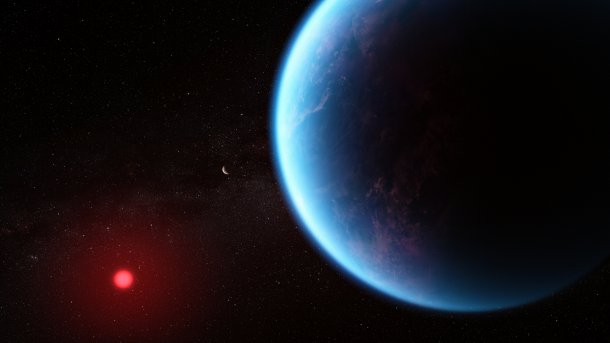Exoplanet: Probably no possible trace of life discovered on huge water world
When the possible discovery of dimethyl sulphide on an exoplanet was announced, there was great excitement. Now a research team is raising doubts.
Artistic representation of K2-18 b
(Bild: NASA, CSA, ESA, J. Olmstead (STScI), N. Madhusudhan (Cambridge University))
The James Webb Space Telescope has probably not found dimethyl sulphide on the exoplanet K2-18 b after all, and thus an indication of possible living beings. This has been determined by a research group at the University of California, Riverside, contradicting initial findings that had at least suggested a sensational discovery. As the research team now explains, the signals found are probably not attributable to dimethyl sulphide and are likely to have their origin in methane. Under the circumstances, it is not possible for the ultra-modern instrument to distinguish between dimethyl sulphide (DMS, or C2H6S) and methane. In principle, however, such a discovery is possible - if significantly more DMS is produced on an exoplanet than on Earth.
Not proven here, but possible in principle
As study leader Shang-Min Tsai now explains, the signals found were not strong and "only emerged after a certain evaluation of the data". This is why the new analysis was started. The data was simulated using computer models that considered the physical and chemical properties of DMS as well as a hydrogen-rich atmosphere. They were able to show that the space telescope could not distinguish between methane and DMS under these circumstances. For dimethyl sulphide to occur in detectable quantities, possible extraterrestrial organisms would have to produce 20 times more than on Earth.
The fact that traces of dimethyl sulphide were allegedly found in K2-18 b was explained in the fall. On Earth, the compound is only produced by living organisms and is responsible for the typical smell of the sea, for example. The alleged discovery may even have led to speculation that the space telescope had found evidence of extraterrestrial life. NASA has denied this, but at least not completely. The paper now published in the Astrophysical Journal Letters by the research group from California reinforces the doubts that such a groundbreaking discovery was actually made on the exoplanet.
K2-18 b is the first exoplanet in the habitable zone of a star where water has been detected. This means that it can, in principle, occur there in a liquid state. This discovery was made public in 2019. Since then, the exoplanet has been in the spotlight and there is growing evidence that it is a huge water world in whose gigantic ocean microbiological life could develop. This would mean that we have concentrated on the wrong exoplanets in our search for extraterrestrial life – because they are too similar to Earth. "Hycenaean" planets such as K2-18 b – from the English terms for hydrogen ("hydrogen") and ("ocean") – 9 can be much larger and still be life-friendly. K2-18 b, for example, has almost nine Earth masses.
(mho)
